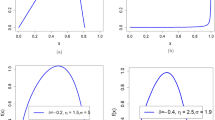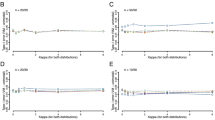Abstract
A SHORT account appeared in NATURE, October 12, p. 584, of a paper read by me at the British Association, entitled the “Median Estimate,” which will appear in the forthcoming Journal of the Association. Its object was to solve a problem of the following kind:—40 per cent, of the members at a meeting vote that a proposed grant should be less than 100l., 80 per cent, vote that it should exceed 500l. What is the Median Estimate, supposing the normal law of frequency to hold good? That is to say, What is the sum that one-half of the members would think too little, and the other half too much, and which therefore presents the best compromise between many discordant opinions? I showed that the calculation was exceedingly simple if certain tabular values are used that will be spoken of later. But, on after reflection, it seems to me that further simplification is both desirable and feasible. The problem is representative of a large class of much importance to anthropologists in the field, few of whom appear to be quick at arithmetic or acquainted even with the elements of algebra. They often desire to ascertain the physical characteristics of races who are too timorous or suspicious to be measured individually, but who could easily be dealt with by my method. Suppose it to be a question of strength, as measured by lifting power, and that it has been ascertained that a per cent. of them fail to lift a certain bag A of known weight, and that b per cent. of them fail to lift another heavier bag B. From these two data, the median strength can be determined by the simple method spoken of above, and not only it but also the distribution of strengths among the people. Having indicated the utility and importance of the general problem, I will proceed to work out the particular case of the voters by the now further simplified method. In Fig. 2 let the base line G represent 100l. and let each successive horizontal line above it represent an increment of 100l. A dot A is placed on G, at the division 40°, and another dot B is placed on the ordinate at the division 80° at the level of the fourth line above G. Therefore A and B are plotted at their respective places. Join the two dots with a straight line. The place where this line cuts the ordinate at 50°, shows the Median value. The principle on which this exceedingly simple process rests must be explained by beginning with Fig. 1, where an ordinary curve of distribution is drawn about the axis H, with a quartile equal to 1. The centiles from the axis to the curve are given in the following small table (see my “Natural Inheritance,” Macmillan, 1889) which is reproduced here for convenience.
This is a preview of subscription content, access via your institution
Access options
Subscribe to this journal
Receive 51 print issues and online access
$199.00 per year
only $3.90 per issue
Buy this article
- Purchase on Springer Link
- Instant access to full article PDF
Prices may be subject to local taxes which are calculated during checkout
Similar content being viewed by others
Rights and permissions
About this article
Cite this article
GALTON, F. A Geometric Determination of the Median Value of a System of Normal Variants, from two of its Centiles. Nature 61, 102–104 (1899). https://doi.org/10.1038/061102g0
Issue Date:
DOI: https://doi.org/10.1038/061102g0
Comments
By submitting a comment you agree to abide by our Terms and Community Guidelines. If you find something abusive or that does not comply with our terms or guidelines please flag it as inappropriate.



